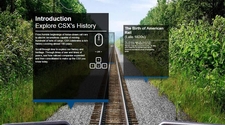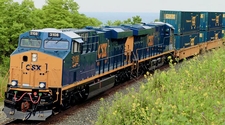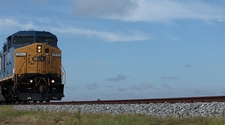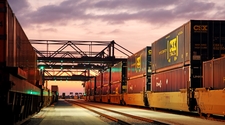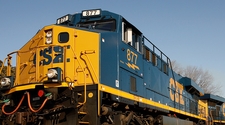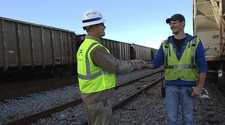| Safety Valve |
A valve arranged to open at a predetermined pressure for which it has been adjusted. It is used to limit maximum pressure in intercoolers, main reservoirs, and control valves. |
| Sales Territory Directory |
A publication which lists all geographical locations in the United States, Canada and Mexico served by railroads. It shows which railroad serves the location and which Regional and District Sales Managers are responsible for the customers at a specific location. |
| Salvage |
The monies recovered for merchandise that was lost or damaged during transit. |
| Sand House |
A facility where locomotives are supplied with sand. OR Rumors or gossip pertaining to the railroad and its personnel. |
| Sanders |
Devices operated by air for applying sand to the rail in front of or behind the driving wheels of the engine to maintain traction. |
| Satellite Monitored Automated Rail Tracking Car (AKA SMART Car) |
Cars that are able to detect rough handling problems created by excessive coupling speeds and impacts created during train operations. SMART cars utilize a Ground Positioning Satellite (GPS) navigational device and impact sensor technology that reports over speed impact events in real time. This data is then made available to applicable personnel. SMART cars assist the Engineering, Mechanical, Sales & Marketing, and Transportation departments in preventing damage to lading during transit. SMART cars impro |
| Sawtoothing |
The shifting of packaged goods that sometimes occurs when the straight stack method of loading is used. |
| Scale |
See Scale, Railroad. |
| Scale House |
Structure erected to house weight recording mechanisms used in weighing freight cars. |
| Scale Test Car |
A compact car equipped with weights for the testing of track scales. |
| Scale Ticket |
A piece of paper pasted over the "Weight Block" of a waybill indicating that the car has been weighed. |
| Scale Track |
A track on which a permanent scale is located. Also a storage track for cars needing to be weighed. |
| Scale, Railroad |
A device for weighing railroad cars. Weight of the contents is determined by subtracting the light weight of the car from the gross weight and is used to determine the cost of transportation. The three types of scales include: static, weigh-in-motion, and coupled-in-motion. |
| Schedule |
That part of a timetable which prescribes direction, number, frequency and times for movement of scheduled trains. |
| Schnabel Car |
A specially constructed car, having two separable interlocking units that form the car body. Units may be separated and load interposed between and locked in place to form a complete unit. |
| SCO (Special Car Order) |
Rules established by AAR to provide the shortest route-miles return of empty equipment to its owner. |
| Scrapped |
A car that has been sold as scrap due to age or damage. |
| Seals |
Metal strips, designed for one-time use, applied to the hasp of closed freight car doors. To remove, they must be broken. They are used to indicate whether or not the contents have been tampered with while in transit. They are stamped with a name, initial and/or number for identification. |
| Secondary Cell |
Any combination of two metals or metalloids immersed in an electrolyte which in itself will not produce electricity without first having the metallic portion of the element decomposed by the passage of electric current. |
| Secondary Tracks |
Any designated track upon which trains or engines may be operated without timetable authority, train orders or block signals. |
| Section |
Transportation: One of two or more trains, running on the same schedule, or for which signals are displayed. OR Engineering: A portion of the railroad assigned to a section foreman. |
| Section Hand (AKA Sectionman) |
See Trackman. |
| Sectional Tariff |
A tariff made in sections, with each section containing different rates between the base points with provisions for the alternate application of the rates. |
| Securement Devices |
Devices equipped on rail and intermodal equipment for securement system attachment, such as belt rails for DF-type bar or lumber equipped with clips. Intermodal may use slotted sidewall posts which are also known as logistic posts. Some are permanently equipped with devices such as curtains. |
| Segment |
In IMS/VS, the unit of access to a database. For the database system. OR The smallest amount of data that can be transferred via one database call. |
| Selective Rate Increase |
Increases published in Tariff Series 9000 referred to as 9000, 9500, or increases that are published within individual tariffs on selected commodities. |
| Self-Aligning Coupler |
A coupler which has a taper shank rather than a straight shank to prevent the jackknifing of cars. |
| Separate Independent Factor Through Rate (SIFTR) |
Published joint through rates. There must be at least two carriers involved in order to apply this rate. |
| Separation |
Occurs when the coupler draft gear or knuckle is broken, due to excessive forces, causing a train to pull apart. |
| Service Application |
A brake application of one or more brake pipe reductions made at a service rate. These reductions are controlled by positional changes of the automatic brake valve handle. |
| Service Brake Reduction |
A decrease in brake pipe pressure at a rate sufficient to move the control valve to "service" position, but not rapidly enough to move the valve to "emergency" position. |
| Serving Yard |
Location where cars are delivered to or received from customers. |
| Set Out (AKA Set Off) |
Cars left at designated points by a train. |
| Shanty |
Small building erected along right-of-way to provide shelter. |
| Shared Batch Job |
A job that is processed in a database environment. |
| Shift (AKA Tour of Duty, Stint, Trick, Turn) |
Term applied to the daily work schedule of a plant or its employees. |
| Shift Cars |
To move cars from one place to another. |
| Shifter |
A small industrial switching locomotive. |
| Shifting |
See Switching. |
| Shipment in Bond |
See In Bond Shipment. |
| Shipper (AKA Consignor) |
The person or firm by whom articles are shipped. |
| Shipper Order Notify |
See Order Notify. |
| Shipper's Export Declaration |
A form required by the Treasury Department and filled out by a shipper showing the value, weight, consignee, destination, etc. of shipments to be exported. |
| Shipper's Load and Count (AKA Shipper's Load and Tally) |
A term denoting that the contents of a car were loaded and counted by the shipper and not checked or verified by the railroad. |
| Shipper's Weight Agreement |
A contract between the railroad and the customer in which the railroad agrees to accept either the customer's scale weights or uniform weight approved by a weighing and inspection bureau as entered on the bill of lading. |
| Shipping Order |
Instructions of shipper to carrier for forwarding of goods. Usually a copy of the bill of lading. |
| Shipping Paper |
A shipping order, bill of lading, manifest, or other document serving a similar purpose, that contains the required information (see Hazardous Material Rule 4). |
| Shop |
Term applied to structure where building and repairing railroad equipment is performed. |
| Short Circuit |
A shunt circuit abnormally applied. |
| Short Line |
A transportation line operating over a small territory, usually receiving subsidies from larger railroads. |
| Short Ton (AKA Net Ton) |
2,000 pounds. |
| Shorts |
In train service, cars or blocks of cars to be set-out before the final terminal is reached. |
| Shove (Slang) |
The process of pushing a cut of cars or to push a train from the rear. |
| Shrink Wrap |
To place a tube of film over a unit and apply heat to shrink the film to tightly encompass all the containers in the unit. |
| Shunt Circuit |
A low-resistance connection across the source of supply, between it and the operating unit. |
| Side Bay Caboose |
A caboose car having side bay windows instead of a cupola. This permits the train crew to look along the side of a train, especially when rounding curves for detection of hot boxes or other trouble. |
| Side Track |
A track adjacent to the main track for purposes other than for meeting and passing trains. |
| Siding |
An auxiliary track for meeting or passing trains. It is designated in special instructions. |
| Signal Aspect |
The appearance of a fixed signal conveying an indication, as viewed from the direction of an approaching train, or the appearance of a cab signal conveying an indication as viewed by an observer in the cab. |
| Signal Imperfectly Displayed |
A block or interlocking signal, displaying lights not in conformity with the rules, or the absence of a light where a color light should be, or the absence of a signal at a place where a signal is usually displayed. |
| Signal Indication |
The information conveyed by the aspect of a signal. |
| Signal Mast |
An upright support from which signals are displayed. |
| Signaled Siding |
A siding equipped with block signals that govern train movements on the siding. |
| Signaled Track |
A track equipped with block or interlocking signals that govern train movements. |
| Signboard |
Information stenciled on side of car pertaining to empty car movement instructions. |
| Sill |
The main longitudinal members of a car underframe. |
| Single Track |
A main track upon which trains are operated in both directions. |
| Skate |
See Track Skate. |
| Skew Bridge |
A bridge which crosses a passageway at other than a right angle. |
| Slack |
Lost motion between couplers. OR Amount of free motion in the coupling device between cars. OR Bunching cars in a train so as to relieve the pressure for uncoupling cars. |
| Slow Board |
A signal indication to proceed at slow speed. |
| Slow Speed |
A speed not exceeding 15 mph. |
| Slug |
A locomotive unit equipped with an operating cab, but not equipped with a diesel engine. This type unit has MU capability and traction motors, which receives electrical power from a mother locomotive. |
| Snakeheads |
Broken iron rails. |
| Snapshot (AKA Dynamiter) |
An undesired emergency brake application. |
| Solid Track (Slang) |
Track full of cars. |
| Spacer Car |
A car required between a particular shipment and other freight cars. |
| Span Bolster |
A beam-like structure with each end resting on a conventional truck bolster and arranged to support a car body through a center plate at or near its mid-point. Span bolsters can also be used with two six-wheel trucks to provide 24-wheel (12 axle) support under extremely heavy cars. |
| Special Billing Instructions |
Instructions furnished by the shipper directing the railroad to mail freight bills to a special address or to collect freight charges from a third party. |
| Special Car Orders (SCO) |
Instructions pertaining to certain classes of cars that take precedence over the Code of Service Rules and are in effect for specific reasons. |
| Special Equipment |
Freight cars designed to carry specific commodities, and which may contain devices to protect and/or aid in handling shipments. |
| Special Instructions |
Information contained in timetables and superintendent's bulletins. |
| Specifically-Designed (Container) |
Used for specific commodities (i.e. a bulkhead container platform used to transport oversized tires). |
| Speed Control |
The procedure for maintaining uniform speed, for reducing speed, and for accelerating. This is NOT the term used to describe stopping procedures. |
| Speeds |
Controlled Speed: A speed that will permit stopping within one-half the range of vision. It will also permit stopping short of a train, a car, an obstruction, on-track equipment, or a stop signal. Limited Speed: A speed not exceeding 45 miles per hour. Maximum Authorized Speed: The highest speed permitted for any train on a subdivision or portion of a subdivision. It will be found listed under "Maximum Authorized Speed" in special instructions. Medium Speed: A speed not exceeding 30 miles per hour. Restri |
| Spiked Switch |
A switch with its points held in a fixed position by a track spike to prevent the use of a track or throwing of the switch. |
| SPLC |
Standard Point Location Code. |
| Split Service Application |
The act of making a 6-8 pound initial reduction and following with further reductions, as required. |
| Spot |
To place a car in a designated position or specific location usually for loading or unloading, such as at a warehouse door. |
| Spot for Air |
To position the cars in the yard so as to utilize a central compressed air supply to charge the brake system. |
| Spot System |
A system in which cars and locomotives undergoing repairs are classified and then moved progressively from one spot to another |
| Spotting |
The placing of a car at the proper place for loading or for unloading. |
| Spring Switch |
A switch equipped to restore the switch points to normal position after having been trailed through. |
| Spur Track (Commonly Called Spur) |
A stub track that diverges from main or other tracks which provides access to industrial or commercial areas. It usually dead ends within an industry area. |
| Staggers Act |
Congressional law which deregulated the rail industry allowing each railroad to negotiate rates for shipments on an individual basis. |
| Stanchion |
Vertical bar used to support one end of a trailer while loaded on a flat car. |
| Standard Gauge |
As applied to railway track, the distance of 4 feet 82 inches measured between the heads of the running rails. |
| Standard Rate |
A rate established via direct routes from one point to another. |
| Standard Route |
The line or lines which maintain standard rates. |
| Standing Order |
The actual order of cars in a train from the engine to the last car. |
| Star Marker |
A type of flashing light marker used to designate the rear of a train. Manufactured without telemetry capability. |
| Statement of Difference (S/D) |
A document issued when a carrier finds an error in the settlement of an interline shipment. |
| Static Drop |
A term describing the practice of releasing the hand brakes on standing cars and letting gravity provide the energy to move cars into a track. |
| Station |
A place designated in the timetable by name. |
| Station List |
A printout listing all CSXT stations. |
| Statute of Limitations |
Law limiting time in which claims or suits may be instituted. |
| STCC (Standard Transportation Commodity Code) |
Seven digit code designed to classify all commodities. |
| Stencil |
Device used to aid in labeling cars and locomotives with descriptive and required information. |
| Stock Car |
A car for the transportation of livestock equipped with slatted sides, single or double deck and sometimes with feed and water troughs. |
| Stop Credit |
Process to stop computer tracing for payment of freight billing. |
| Stop-Off Agent |
The freight agent actually performing the stop. |
| Stop-Off Charges |
Charges by a transportation line for stopping a car in transit. |
| Stop-Off Location (AKA Stop-Off) |
A location between origin and destination at which a car stops to complete loading or to partially unload. |
| Stopping In Transit |
The holding of a shipment by the carrier on the order of the owner after the transportation movement has begun and before it is completed, generally to complete loading or to partially unload. |
| Storage |
A term which refers to an area in a computer where data can be entered, held, and removed. OR A charge assessed against consignors, consignees, or assignees on shipments held in freight warehouses on company property beyond the time allowable in the tariff. |
| Storage In Transit |
The storage of freight at a point located between the point of origin and destination which is to be reforwarded at a later date. |
| Storage Track or Yard |
A place to store or hold rail cars. |
| Store Door Delivery |
Delivery to consignee's receiving platform by motor vehicle. |
| Straight Bill of Lading |
A non-negotiable document. Surrender of the original is not ordinarily required upon delivery of property, except when necessary to identify the consignee. |
| Straight Demurrage |
The absence of an agreement between a customer and a transportation line. Each time a car or a group of cars is released to and returned by a customer, a separate demurrage bill is prepared and mailed to the customer. |
| Straight Stack |
A loading method where packages of like size are stacked one on top of another and side by side. |
| Stretch |
An order to the engineer to pull on a cut of cars to see if they are coupled. |
| Stretch Braking |
A method of speed control with the train brakes applied and the locomotive developing power. This tends to keep the slack in draft or stretched condition. |
| Stretch Wrap |
Method of unitizing which involves placing one or more layers of film around a unit. The film is applied under tension and is sealed by heat or self-adhesion. |
| String (Slang) |
Two or more freight cars coupled together. Also a cut. |
| Stringlining |
Excessive lateral forces caused by heavy draft loading, resulting in wheels lifting over the low rail or the rail rolling over. |
| Stub Track |
A form of side track connected to a running track at one end only and usually protected at the end by some form of bumping post or other solid obstruction. |
| Subdivision |
A portion of a division/service lane/business unit designated by timetable. |
| Subsidiary |
A company owned by another company that controls a majority of its stock. |
| Superintendent's Bulletin (AKA General Bulletin) |
Written special instructions about the movement or safety of trains and employees. Superintendent's Bulletins are issued by the division superintendent/service lane general manager. |
| Superintendent's Notice (AKA General Notice ) |
A posted notice of information/instructions issued by the division superintendent. |
| Superior Train |
A train having precedence over another train. |
| Supplement |
An addendum to a tariff published to amend or cancel a tariff. |
| Surcharge |
A charge above the customary charge. Generally applicable to light-density traffic or claimed revenue shortfalls by issuing carriers. |
| Surface Transportation Board (STB) |
The Surface Transportation Board was established on January 1, 1996 as a decisionally independent, bipartisan, adjudicatory body organizationally housed within the U.S. Department of Transportation (DOT), with jurisdiction over certain surface transportation economic regulatory matters. The STB adjudicates disputes and regulates interstate surface transportation through various laws pertaining to the different modes of surface transportation. Surface transportation matters under the Board's jurisdiction i |
| Switch |
Noun: A device consisting of two movable rails, necessary connections, and operating parts designed to turn a locomotive or car from the track on which it is running to another track. OR Verb: To move cars from one place to another, usually within a defined territory. |
| Switch Back |
Track constructed in a series of zigzag curves in mountainous terrain to reduce rate of climb or descent. |
| Switch Delivery |
Term applied when a car is interchanged from one railroad to another for direct delivery to patron. The receiving road is paid a switching rate in lieu of a portion of the road haul freight charges since it does not transport the shipment outside of the switching limits. |
| Switch Engine |
A locomotive used for switching cars in yards and terminals. |
| Switch Heater |
A device used for melting snow or ice in and around movable parts of switches. |
| Switch List |
A listing of cars to be sorted or moved. |
| Switch Lock |
A fastener, usually a spring padlock, used to secure the switch or derail stand in place. |
| Switch Order |
An order to move a car from one place to another within switching limits. |
| Switch Stand |
A device by which a switch is thrown, locked, and its position indicated. It consists essentially of a base, spindle, lever and connecting rod, and is usually furnished with a lamp and banner signal. |
| Switch Target |
A visual day signal fixed on the spindle of a switch stand, or the circular flaring collar fitted around the switch lamp lens, and painted a distinctive color to indicate the position of the switch. |
| Switcher |
A road assignment that spots, pulls, and classifies cars within a terminal or industrial area. |
| Switching |
The process of putting cars in a specific order (as in a classification yard), placing cars for loading or retrieving empties (industrial switching), or the process of adding or removing cars from a train at an intermediate point. OR The movement of cars from one point to another within the limits of an individual plant, industrial area, or a rail yard. Intermediate switching: Service performed by a carrier who neither originates nor terminates the shipment. Inter-plant switching: Movement of a car from o |
| Switching Carrier |
Spots the car at the consignee but does not participate in the road haul and receives only a switching charge for this service. |
| Switching Limits |
Boundaries within which switching rules and charges apply. |
| Switching Movement (Relating to Hazardous Materials) |
An operation, whether inside or outside of a yard, where rail cars are switched, classified, and assembled. The movement of the cars must not exceed one mile. Exception: The movement of a hazardous materials car more than one mile within the same yard is a switching movement if no public road crossings are crossed. |
| Switchman |
See Trainman. |
| Synonym File (ARZ) |
A list of the various names a patron might have in a specific city or state which highlights the preferred patron name in that city or state. |
| System Bulletin |
Written special instructions about the movement or safety of trains and employees. System Bulletins are issued by the Director of Operating Practices. |
| System Notice |
A posted notice of information and instructions issued by the Director of Operating Practices. |
| back to top |


